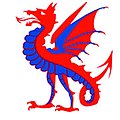Wyvern
This article needs additional citations for verification. (May 2007) |
A wyvern (or wivern, derived from the Anglo-Saxon word for serpent) (Template:PronEng) is a legendary winged reptilian creature often found in medieval heraldry. Its usual blazon is statant (standing). Its origin is in Europe.
The name "wyvern" derived from the Saxon word Wivere, which means "serpent". The French wyvern is known as the Vouivre. Both words are etymologically related to viper.
The wyvern is regarded as a type of dragon. Depictions often include two legs and two wings.[1] Sometimes there are eagle's claws on the wingtips. The rest of its appearance can vary, such as appearing with a tail spade or with a serpent-like tail.
The wyvern has a similar appearance to another mythical creature, the cockatrice.
Heraldry and symbolism
Wyverns can symbolise envy, war, pestilence, and viciousness.[2]
However, they are common in heraldry. The wyverns' symbolism is nobler in this aspect. Wyverns have been depicted in heraldry on shields and bananas for hundreds of years. They are a sign of strength to those who bear the symbol. They also symbolise power and endurance.
Stephen Friar speculates that the wyvern entered British heraldry as the standard of the Roman cohort and later appeared as the "burning dragon" of Cadwalladr (the origin of the red dragon of Wales).[3]
The wyvern was the emblem of the rulers of Wessex and the word "Wyvern" is associated with the many areas of Wessex, reflected in many county and town heraldries of the South West and west of England. It also has been used farther afield in Herefordshire and Worcestershire, as the rivers Wye and Severn run through Hereford and Worcester respectively. Therefore, the wyvern is often used as a mascot in the west and south west. For example, one of the local radio stations is called Wyvern FM, and its first logo, in 1982, featured a wyvern dragon.
-
Wyvern crest surmounting the arms of the Midland Railway at Derby Midland railway station (see text) -
Wyverns in the emblem of Leyton Orient F.C., (based in East London) -
The "dragon" in the logo of the Dragon School, Oxford, is what would now be described as a wyvern -
Birkdale School, Sheffield also uses a stylised wyvern emblem.
- Other British
- A golden wyvern was featured on the flag of King Harold Godwinson of England and is depicted in the Bayeux Tapestry.[4]
- The 43 (Wessex) Division in WW1 and WW2 and latterly the 43 (Wessex) Brigade of the British Army have a golden wyvern as their symbol, worn on the left shoulder of the uniform.
- Vauxhall had a model in its range in the 1950s called the Wyvern.
- The logo of Hummersknott School in Darlington, County Durham has this on it
- The wyvern also appears in the crest of Kingswood School, Lansdown, Bath.
- The wyvern is the crest of Mid-Cheshire District Scouts with a blue background.
- Commonwealth
- A wyvern appears on the crest of Queen's College (University of Melbourne).
- The Wyvern sits upon the crest of King's College, University of Queensland. The all male college embraces it and each student is taught to embody the spirit of the Wyvern. This is often exampled with a cry of "All Hail the Great Wyvern". The word "Wyvern" is also used as a euphemism in many social situations.
- The Wyvern also sits upon the crest of Wesley College Dublin, Ireland, and also on the shield of Wesley College, Perth (upper right-hand quarter).
- The Wyvern is part of the crest of Newington College, Sydney, New South Wales, Australia. One of the preparatory schools is named Wyvern House.
- United States of America
- A red wyvern rampant is the school mascot of Saint Francis High School in Louisville, Kentucky.
- The Distinctive Unit Insignia and arms of the U.S. 37th Armor Regiment are charged with a legless wyvern.
- The Wyvern is the mascot for Kingswood-Oxford School.
- The Wyvern Club was a club founded by several New Orleans men, which met at Antoine's Restaurant in New Orleans.
- The chemistry professional fraternity Alpha Chi Sigma uses the wyvern, representing ignorance, as a mascot.
Cryptozoology
Some cryptozoologists have theorized that wyverns are evidence of surviving pterosaurs, a large flying reptile thought to have gone extinct around 65 million years ago.[5] There are alleged sightings of pterosaurs in remote areas such as the Kongamato in Africa.[6] There is no evidence to prove these hypotheses or sightings. More probable is that the discovery of fossilized skeletons of long extinct species led people to reconstruct those creatures' appearances, and prehistoric and ancient peoples would not have had any reason to believe the creatures represented by the fossils were all dead.
References
- ^ Pennick, Nigel (1997). Dragons of the West. Capall Bann Publishing
- ^ The Dragon Stone http://www.polenth.com/myth/europe/wyvern.html Retrieved Apr. 23, 2007.
- ^ Friar, Stephen (1987). A New Dictionary of Heraldry. London: Alphabooks/A & C Black. pp. p 380. ISBN 0906670446.
{{cite book}}:|pages=has extra text (help); Cite has empty unknown parameter:|1=(help) - ^ Flags of the World: Wessex, England http://www.crwflags.com/fotw/flags/gb-wessx.html Retrieved May 25, 2007
- ^ Unknown Explorers - Wyvern http://www.unknownexplorers.com/wyvern.php Retrieved Apr.26, 2007.
- ^ The Wonderful World of Cryptozoology - http://www.rainsnow.org/wod_cryptozoology.htm Retrieved Apr. 26, 2007.


